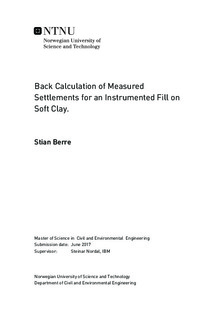Back Calculation of Measured Settlements for an Instrumented Fill on Soft Clay.
Master thesis
Permanent lenke
http://hdl.handle.net/11250/2458793Utgivelsesdato
2017Metadata
Vis full innførselSamlinger
Sammendrag
Settlement problems in areas with soft sensitive clays are encountered in many parts of Norway and especially in areas of central Norway. Sampling of sensitive soft soils is challenging and often results in low quality samples which are hard to interpret. Back-calculations of observed field measurements and re-evaluation of laboratory samples can give better understanding of soil behavior for soft clays.
This study describes the performance of a full-scale fill constructed on soft clay, stabilized with pre-fabricated vertical drains in Klett, central Norway. A section of the fill has been investigated in detail using the finite element software Plaxis, where exact geometry and load application of the fill has been recreated through available data. Predictions of vertical displacement and pore pressure development are made and compared with field measurements.
A large number of laboratory tests have been investigated through background theory, and characteristic soil parameters have been interpreted. Two material models were used in the numerical analysis. In addition to a conventional model that accounts for creep, a more advanced user defined model was utilized to investigate the effect of destructuration.
This study has shown that a very good agreement between calculated and observed settlement can be achieved with an exact reconstruction of the fill in Plaxis. Both vertical displacement and pore pressure development are in line with field measurement, but deviations occur for first predictions. Verification against laboratory test data shows that both material models underpredict pore pressure development. Modifications and the use of the user defined model show very good fit for the first 280 days and the final prediction show almost an identical settlement development.
